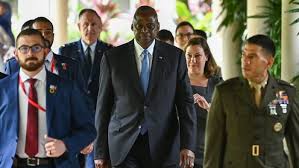A top Chinese general has accused the US of trying to build an “Asia-Pacific version of NATO,” underlining the persistent tensions between Washington and Beijing. This accusation came just one day after the two countries’ defense chiefs met for the first time since 2022, aiming to improve military communications. Lieutenant General Jing Jianfeng’s denunciation of the US as the “source of chaos and tension” in the Indo-Pacific encapsulates the complex and fraught relationship between these two global powers.
The US and Its Indo-Pacific Strategy
US Defense Strategy in the Indo-Pacific
US defense secretary Lloyd Austin highlighted the ways the Biden administration is collaborating with allies to boost deterrence in the Indo-Pacific region. This strategy involves creating a “set of overlapping and complementary initiatives and institutions” to enhance military cooperation, develop new capabilities, and ensure regional security.
Building Alliances
Austin emphasized the historic “convergence” of defense interests among the US and its Indo-Pacific allies, including Japan, Australia, the Philippines, and South Korea. This cooperation is designed to counter perceived threats and enhance collective security in the region.
China’s Perspective
Accusations Against the US
Lieutenant General Jing Jianfeng responded to Austin’s speech by accusing the US of attempting to establish an “Asia-Pacific version of NATO” to maintain its hegemony. Jing argued that Washington’s strategy aims to “create division, provoke confrontation, and undermine stability” in the region.
China’s Response to Regional Security Initiatives
Jing claimed that the US’s efforts to integrate regional security interests are merely a means to “tie the region’s countries to the US war chariot.” This reflects Beijing’s long-standing suspicion of US intentions in the Indo-Pacific.
The Debate Over Regional Stability
US Defense Officials’ Rebuttal
US officials have rejected Beijing’s argument, asserting that American allies are enhancing their security cooperation due to China’s aggressive actions in the region. A senior US defense official stated, “Countries here in the region believe it is in their national security interest to be working more with each other and more with the US.”
Commitment to Regional Security
Austin reiterated the US’s commitment to regional security, stating, “We’re all in. And we’re not going anywhere.” This declaration underscores the US’s determination to remain a key player in Indo-Pacific security affairs.
The First Meeting Since 2022
Austin and Dong Jun’s Dialogue
The exchange between Austin and Jing came shortly after Austin met with Dong Jun, China’s defense minister since December. This meeting marked the first dialogue between US and Chinese defense ministers since late 2022, reflecting a cautious step towards improving military communications.
Progress and Persistent Tensions
While some progress has been made, tensions remain high over various issues, from Taiwan to Chinese aggression towards the Philippines. These persistent tensions highlight the complexities of US-China relations in the Indo-Pacific.
Flashpoints in the Indo-Pacific
Philippines and Second Thomas Shoal
In his speech, Austin accused China of dangerously harassing the Philippines around Second Thomas Shoal, a disputed reef. Chinese coast guard vessels have used water cannons to block Manila’s resupply missions, an act Austin described as “dangerous — plain and simple.”
Philippines’ Stance
Philippine President Ferdinand Marcos Jr condemned China’s “illegal, coercive [and] aggressive” activities and warned that any act killing a Filipino citizen would be considered akin to “an act of war.”
Taiwan: A Major Flashpoint
China’s Harsh Rhetoric
Jing stepped up China’s harsh rhetoric on Taiwan’s new government, accusing President Lai Ching-te of pushing Taiwan towards “an abyss of disaster” by seeking independence through foreign support or force. The PLA conducted two days of military exercises around Taiwan last week, calling it a “punishment” for Lai.
Australia’s Criticism
Australia’s defense minister Richard Marles criticized China’s military actions around Taiwan, stating they “do not inspire confidence that China prioritizes or is planning for a peaceful settlement.”
Calls for Restraint
Indonesia’s Appeal
Indonesia’s defense minister and president-elect Prabowo Subianto urged leaders in Southeast Asia to exercise restraint. He called on the leaders of China and the US to recognize their global responsibilities and seek peaceful solutions.
Global Leadership Responsibilities
Prabowo’s call for restraint and responsible leadership reflects the broader concerns in Southeast Asia about the potential for conflict between major powers.
US Commitment to Ukraine
Support for Ukraine
US defense officials stated that Austin would reaffirm the US commitment to ensuring Ukraine has the necessary resources to defend itself against ongoing Russian aggression. This commitment underscores the US’s broader strategic interests beyond the Indo-Pacific.
Zelenskyy’s Visit
Ukrainian President Volodymyr Zelenskyy’s visit to Singapore to meet Indo-Pacific defense officials, including Austin, highlights the interconnected nature of global security concerns and the US’s multifaceted approach to international alliances.
The US-China tensions in the Indo-Pacific are a complex interplay of strategic interests, regional alliances, and global power dynamics. While the US seeks to strengthen its alliances and deter aggression, China perceives these actions as attempts to encircle and undermine its influence. As both sides navigate these turbulent waters, the region’s stability hangs in the balance. Through dialogue and diplomatic efforts, there remains hope for mitigating tensions and fostering a more stable and cooperative Indo-Pacific.




